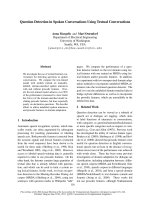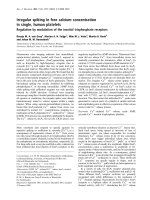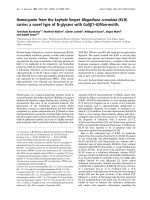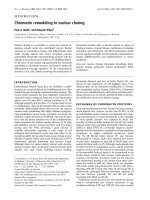Báo cáo y học: " SIVdrl detection in captive mandrills: are mandrills infected with a third strain of simian immunodeficiency virus?" potx
Bạn đang xem bản rút gọn của tài liệu. Xem và tải ngay bản đầy đủ của tài liệu tại đây (359.43 KB, 5 trang )
BioMed Central
Page 1 of 5
(page number not for citation purposes)
Retrovirology
Open Access
Short report
SIVdrl detection in captive mandrills: are mandrills infected with a
third strain of simian immunodeficiency virus?
Antoinette C van der Kuyl*
1
, Remco van den Burg
1
, Mark J Hoyer
2
,
Rob A Gruters
3
, Albert DME Osterhaus
3
and Ben Berkhout
1
Address:
1
Department of Human Retrovirology, Academic Medical Centre, University of Amsterdam, Meibergdreef 15, 1105 AZ Amsterdam, The
Netherlands,
2
Artis, Plantage Kerklaan 38–40, 1018 CZ Amsterdam, The Netherlands and
3
Department of Virology, Erasmus Medical Centre, P.O
Box 1738, 3000 DR Rotterdam, The Netherlands
Email: Antoinette C van der Kuyl* - ; Remco van den Burg - ;
Mark J Hoyer - ; Rob A Gruters - ; Albert DME Osterhaus - ;
Ben Berkhout -
* Corresponding author
Abstract
A pol-fragment of simian immunodeficiency virus (SIV) that is highly related to SIVdrl-pol from drill
monkeys (Mandrillus leucophaeus) was detected in two mandrills (Mandrillus sphinx) from
Amsterdam Zoo. These captivity-born mandrills had never been in contact with drill monkeys, and
were unlikely to be hybrids. Their mitochondrial haplotype suggested that they descended from
founder animals in Cameroon or northern Gabon, close to the habitat of the drill. SIVdrl has once
before been found in a wild-caught mandrill from the same region, indicating that mandrills are
naturally infected with a SIVdrl-like virus. This suggests that mandrills are the first primate species
to be infected with three strains of SIV: SIVmnd1, SIVmnd2, and SIVdrl.
Findings
To date over 30 strains of simian immunodeficiency virus
(SIV) have been isolated from African primate species and
sequenced [1]. Mandrills (Mandrillus sphinx) are quite
exceptional among African monkeys in that they harbour
two distinct SIV strains, designated SIVmnd1 and
SIVmnd2, with a separate geographic distribution [2,3]
(see also Figure 1A). SIV infections are mostly non-patho-
genic in their natural hosts. SIVmnd1, despite high virus
levels in chronically infected mandrills, has only a small
effect on the T-cell counts, and primary infection does not
induce clinical symptoms [4,5]. However, two cases of
immunodeficiency were reported in mandrills after long-
term (>18 years) SIV infection [6]. In 2003, a 20-year old
male captive mandrill (mandrill CAS) housed at Artis Zoo
(Amsterdam, The Netherlands), suffering from heart fail-
ure and poor general condition, was found to be positive
for serum SIV antibodies. Inspection of the other three
mandrills of his group, a ten-year old female (mandrill
REB) and their offspring (mandrills RAF, 3 years old and
HAB, 2 months old), showed that the female and one of
the offspring (HAB) were also SIV antibody-positive.
Both EDTA-plasma and PBMC (isolated with the Opti-
Prep system (Nycomed, Oslo, Norway)) was obtained
from the animals for further analysis. Our goal was to
investigate whether the monkeys were virus carriers, and
which strain of SIV they harboured. To detect both
SIVmnd1 and SIVmnd2, we designed two nested primers
sets based on published pol gene sequences that amplify
an RT fragment of 282 nucleotides (Table 1). Nucleic
acids were isolated from PBMC by a procedure using silica
Published: 01 November 2004
Retrovirology 2004, 1:36 doi:10.1186/1742-4690-1-36
Received: 30 September 2004
Accepted: 01 November 2004
This article is available from: />© 2004 van der Kuyl et al; licensee BioMed Central Ltd.
This is an Open Access article distributed under the terms of the Creative Commons Attribution License ( />),
which permits unrestricted use, distribution, and reproduction in any medium, provided the original work is properly cited.
Retrovirology 2004, 1:36 />Page 2 of 5
(page number not for citation purposes)
and guanidium thiocyanate [7]. cDNA was synthesized
with the 3'primer and AMV-RT (Roche Diagnostics, Penz-
berg, Germany). PCR amplifications were performed
using the following protocol: denaturation for 5 min at
95°C and amplification for 35 cycles (first PCR) or 25
cycles (second PCR) of 1 min at 95°C, 1 min at 55°C, and
2 min at 72°C, followed by an extension of 10 min at
72°C. Products were cloned with the TOPO TA cloning kit
(Invitrogen, San Diego, Calif.). Sequencing of at least four
clones per sample was done with the Bigdye Terminator
Cycle Sequencing kit and an ABI 377 automated
sequencer (both from ABI, Foster City, Calif.), using M13
forward and M13 reverse primers. For species identifica-
tion, fragments of the mitochondrial 12S and cytochrome
B genes were amplified [8], and sequenced.
Mitochondrial 12S and cytochrome B sequences were
identical in all four animals and confirmed that the
A) Geographic distribution of the genus Mandrillus, based upon mitochondrial haplotypes (adapted from [10]), and the SIV strains they harbourFigure 1
A) Geographic distribution of the genus Mandrillus, based upon mitochondrial haplotypes (adapted from [10]), and the SIV
strains they harbour. B) Phylogenetic tree generated with Kimura-2-parameter distances and the NJ option of the MEGA pack-
age
, from 267 nt of the mitochondrial cytochrome b gene of the four captive mandrills and refer-
ence sequences from GenBank (accession numbers are indicated). C) Phylogenetic tree generated with the NJ option of
MEGA, based upon Kimura-2-parameter distances of SIVpol nucleotide fragments from captive mandrills CAS and REB, and
reference sequences for SIVdrl, SIVmnd1, and SIVmnd2, respectively. Numbers shown are bootstrap confidence levels (BCL).
D) SIV-pol amino acid consensus sequence from captive mandrills compared with homologous sequences from SIVdrl and
SIVmnd2, respectively. The translated SIV-Artis sequence is the consensus sequence of 14 PCR clones derived from two ani-
mals. The YMDD motif within the catalytic core of the RT enzyme is underlined.
CAS
HAB
REB
RAF
AF301615
AY204775
AF020588
99
0.01
CAS1
CAS2
CAS3
CAS4
REB1
REB4
REB2
REB3
REB6
REB5
REB7
CAS6
CAS5
CAS7
AY159321(SIVdrl)
AY159322(SIVmnd2)
AF367411(SIVmnd2)
M27470(SIVmnd1)
70
98
100
94
73
58
82
71
60
87
69
57
10
SIV-Artis DFRKYTAFTIPSVNNQGPGIRYQYNVLPQGWKGSPAIFQATADKILQPFREKNPDVIIYQYMDDLFVGSDRPKHLHDQMIKELRTHLRFWGLETPDKKFQDNPPYEWM
SIVdrl AY159321 E K
SIVmnd2 AY159322 KA-K H-E-L LSASE-SK V E Q KE—-F
SIVmnd2 AF367411 RH V VAPE-SR Q D L KE—-F
SIVmnd1 M27470 -Y-P V A K M C G-VASL-EV KNH-T-QL YTAEE KA-V AL-MT-N E Y-KE FH
M. sphinx northern cyt b haplotype
M. leucophaeus cyt b
M. sphinx southern cyt b haplotype
SIVmnd2 primers
SIVdrl primers
C
B
D
A
Retrovirology 2004, 1:36 />Page 3 of 5
(page number not for citation purposes)
monkeys were M. sphinx [9,10]. In addition, the cyto-
chrome B sequences were indistinguishable from the
recently described northern mandrill haplotype (Figure
1B) [10], suggesting that the captive animals descended
from founders originating from a locale north of the
Ogooué River (see Figure 1A). SIV-pol fragments could be
amplified from PBMC of both adult mandrills CAS and
REB with the primer set specific for SIVmnd2, but not with
SIVmnd1 specific primers. However, analysis of the
cloned fragments showed that these were 96–97% identi-
cal to SIVdrl-1FAO (GenBank acc. no. AY159321) isolated
from a drill monkey (Mandrillus leucophaeus), with a lower
sequence identity to SIVmnd2 (± 85% to GenBank acc.
no. AF367411), and to SIVmnd1 (<64% to GenBank acc.
no. M27470). Although SIVmnd2 and SIVdrl are more
closely related to each other than the two SIVmnd strains,
SIVdrl has several mismatches with the PCR primers
designed for detection of SIVmnd2. This could explain
why one seropositive animal was tested as PCR-negative.
Therefore, we designed a new primer set that amplifies the
same gene fragment based on the SIVdrl sequence (Table
1). Reanalysis of the mandrill PBMC samples with this
drill-specific primer set again resulted in only two positive
samples from the two adult animals: mandrills CAS and
REB. Sequence analysis confirmed the high similarity to
SIVdrl-1FAO (97%), and a lower similarity to SIVmnd2
(87%). SIV pol fragments from both mandrills were 98–
99% similar to each other. Clones obtained from a single
animal with the two primer sets were not identical to each
other (98–99% identity), suggesting that each PCR ampli-
fied a subset of the virus population (Figure 1C).
Mandrills presently inhabit Cameroon, Gabon, and the
southwestern part of the Republic of Congo. Two mito-
chondrial haplotypes are described in this species, sepa-
rated by the Ogooué River in Gabon [10]. Interestingly,
the distribution of mandrill SIV strains follows approxi-
mately the same geographic distribution, with SIVmnd1
being present in the southern part of the mandrill range,
and SIVmnd2 in the northern part. Drill monkeys are
found in Nigeria and Cameroon separated from the man-
drill territory by the Sanaga River (Figure 1A). Mandrills
and drills are currently believed to be non-sympatric, but
it is not unlikely that the situation was different in the
past.
SIVmnd2 and SIVdrl are closely related, and both are
equidistant from SIVmnd1. SIVmnd2 is found in north-
ern mandrills, which are closest to the current drill habi-
tat. A wild-caught mandrill from south Cameroon was
found to harbour a SIVdrl virus strain [3,11], suggestive of
cross-species transmission [11]. Multiple cross-species
transmissions are now believed to obscure the evolution
and distribution of SIV strains in African primate species
[1]. SIV cross-species transmissions are ongoing, and Afri-
can green monkey strains have recently been detected in
patas monkeys and baboons [1,12,13], species that are
found in close proximity to each other.
All four mandrills examined here were born in captivity.
Male CAS was born in 1983 at the now closed Wassenaar
Zoo (The Netherlands), and moved to Artis Zoo in 1986.
The female, REB, was born in Budapest Zoo (Hungary),
and moved to Artis Zoo when she was 5 years old. Their
offspring, RAF and HAB, were both born in Amsterdam.
Exposure to drills during their lifetime is unlikely as none
of the zoos kept drills (M. leucophaeus) at any time. Drills
are rare in European zoos, and only the zoos of Nikolaev
Table 1: PCR primers used to amplify Mandrillus SIV-pol
Primer Sequence ('5→'3) Description Fragment size
SIVmnd1A AGATATAGGGGATGCCTATT 5' first primer A-B = 356 nt
SIVmnd1B TCTTCCACTTATCTGGGTGT 3' first primer
SIVmnd1C AGATTATAGACCCTATACTGC 5'second primer C-D* = 282 nt
SIVmnd1D CATCCAATGAAAGGGAGGTTC 3' second primer
SIVmnd2A GGACATAGGGGATGCCTATT 5' first primer A-B = 356 nt
SIVmnd2B CTGTCCATTTCTTTGGGTGC 3' first primer
SIVmnd2C GGACTTTAGAAAGTACACTGC 5'second primer C-D* = 282 nt
SIVmnd2D CATCCACTCAAAGGGAGGTTC 3' second primer
SIVdrlA GGATGTAGGTGATGCCTATT 5' first primer A-B = 356 nt
SIVdrlB CTGTCCACTTCTTTGGATGC 3' first primer
SIVdrlC = SIVmnd2C 5'second primer C-D* = 282 nt
SIVdrlD CATCCATTCATAAGGAGGATTG 3' second primer
* corresponding to nucleotides 2503–2784 of SIVdrl (acc. no. AY159321)
Retrovirology 2004, 1:36 />Page 4 of 5
(page number not for citation purposes)
(Ukraine) and Saarbruecken (Germany) reported keeping
both drills and mandrills in a 1992 survey [14]. So, it is
improbable that the Artis mandrills acquired SIVdrl from
a recent contact with captive drills. Another way of acquir-
ing a drill SIV strain could be if one of the monkeys was
actually a hybrid between a drill and a mandrill. Hybridi-
sation between different species of Cercopithecinae is pos-
sible, and offspring is sometimes fertile depending upon
the exact species. The genus Mandrillus cannot hybridise in
the wild, as the habitats of the two species do not overlap,
but it does so in captivity. The morphologic differences
between female drills and mandrills are less obvious than
those between males and are mainly noticeable in the col-
ouration of the muzzle and the size of the animal. A single
hybrid M. sphinx × M. leucophaeus has been reported from
Vienna Zoo, Austria, in a 1992 survey [14], and two
hybrid M. leucophaeus × M. sphinx were described from a
Wildlife Rescue Centre in Cameroon [15]. Mitochondrial
sequencing as performed in this study cannot alone be
used to resolve hybridisation, as it only characterises the
mother lineage. The male mandrill is, however, unlikely
to be a hybrid as its description fits exactly that of a male
mandrill. The female was also listed in the Artis Zoo data-
base records as a non-hybrid. She was registered with the
European studbook programme (ESB) for mandrills
supervised by the Budapest Zoo, Hungary, and was born
from registered mandrill parents.
Because SIVdrl was also found in a wild-caught Cameroo-
nian mandrill [3,11], it is plausible that a SIVdrl-like virus
is naturally present in mandrills, making them the only
primate species that is naturally infected with three strains
of SIV. The presence of SIVdrl in one of the two adult cap-
tive mandrills occurred probably through transmission
from a wild ancestor, and this animal probably infected
the other mandrill once joined in Artis Zoo. Sexual and
mother-to-child transmission of SIV in mandrills have
been reported to be rare [16,17]. Here, in offspring born
to a SIV-positive mother SIV could not be detected. The
persistence of maternal antibodies could explain why the
2-month old young tested seropositive, although there is
a possibility of the animal having a viral copy number
below the detection limit of the PCR assay. Transmission
of SIV between mandrills and drills could have taken
place either by biting or sexual contacts. SIVmnd1 is
mainly transmitted between males during aggressive con-
tacts [17], and might also be transmitted when fighting off
other receptive primates species. Sexual transmission
could have occurred during interbreeding. Each of these
possibilities requires an overlap of habitats, which could
have existed in the past.
If we assume that SIVdrl(Artis) left Africa at least ten years
ago (when the female was born in captivity), its genome
conservation is remarkable: only 2 conserved amino acid
differences separate the consensus pol-sequence from the
SIVdrl reference sequence (Figure 1D). However, to gain a
deeper insight into the characteristics and evolution of
this virus strain, a full-length sequence, or at least addi-
tional sequences of the gag or env regions, would be
required. Only then could it be determined whether the
virus carried by the captive mandrills is really SIVdrl or a
novel recombinant virus. Several recombinant SIVs have
been described in naturally infected primate species (see:
[1]). Unfortunately, further sequence analysis is difficult
due to shortage of material as the monkeys were eutha-
nized soon after the SIV antibody test results became
known.
Competing interests
The author(s) declare that they have no competing
interests.
Authors'contributions
ACvdK designed the study, analysed the sequences, and
drafted the manuscript. RvdB carried out the PCR assays
and performed the cloning and sequencing. MJH did the
medical examinations and collected the blood samples.
RAG carried out the SIV antibody assays. ADMEO and BB
conceived of the study, and participated in its
coordination.
Acknowledgements
The authors thank Wim van Est for generating Figure 1A.
References
1. Bibollet-Ruche F, Bailes E, Gao F, Pourrut X, Barlow KL, Clewley JP,
Mwenda JM, Langat DK, Chege GK, McClure HM, Mpoudi-Ngole E,
Delaporte E, Peeters M, Shaw GM, Sharp PM, Hahn BH: New simian
immunodeficiency virus infecting De Brazza's monkeys
(Cercopithecus neglectus): evidence for a cercopithecus
monkey virus clade. J Virol 2004, 78:7748-7762.
2. Souquiere S, Bibollet-Ruche F, Robertson DL, Makuwa M, Apetrei C,
Onanga R, Kornfeld C, Plantier JC, Gao F, Abernethy K, White LJ,
Karesh W, Telfer P, Wickings EJ, Mauclere P, Marx PA, Barre-Sinoussi
F, Hahn BH, Muller-Trutwin MC, Simon F: Wild Mandrillus sphinx
are carriers of two types of lentivirus. J Virol 2001,
75:7086-7096.
3. Takehisa J, Harada Y, Ndembi N, Mboudjeka I, Taniguchi Y, Ngansop
C, Kuate S, Zekeng L, Ibuki K, Shimada T, Bikandou B, Yamaguchi-
Kabata Y, Miura T, Ikeda M, Ichimura H, Kaptue L, Hayami M: Natu-
ral infection of wild-born mandrills (Mandrillus sphinx) with
two different types of simian immunodeficiency virus. AIDS
Res Hum Retroviruses 2001, 17:1143-1154.
4. Onanga R, Kornfeld C, Pandrea I, Estaquier J, Souquiere S, Rouquet P,
Mavoungou VP, Bourry O, M'Boup S, Barre-Sinoussi F, Simon F, Ape-
trei C, Roques P, Muller-Trutwin MC: High levels of viral replica-
tion contrast with only transient changes in CD4(+) and
CD8(+) cell numbers during the early phase of experimental
infection with simian immunodeficiency virus SIVmnd-1 in
Mandrillus sphinx. J Virol 2002, 76:10256-10263.
5. Pandrea I, Onanga R, Kornfeld C, Rouquet P, Bourry O, Clifford S,
Telfer PT, Abernethy K, White LT, Ngari P, Muller-Trutwin M,
Roques P, Marx PA, Simon F, Apetrei C: High levels of SIVmnd-1
replication in chronically infected Mandrillus sphinx. Virology
2003, 317:119-127.
6. Pandrea I, Onanga R, Rouquet P, Bourry O, Ngari P, Wickings EJ,
Roques P, Apetrei C: Chronic SIV infection ultimately causes
immunodeficiency in African non-human primates. AIDS
2001, 15:2461-2462.
Publish with BioMed Central and every
scientist can read your work free of charge
"BioMed Central will be the most significant development for
disseminating the results of biomedical researc h in our lifetime."
Sir Paul Nurse, Cancer Research UK
Your research papers will be:
available free of charge to the entire biomedical community
peer reviewed and published immediately upon acceptance
cited in PubMed and archived on PubMed Central
yours — you keep the copyright
Submit your manuscript here:
/>BioMedcentral
Retrovirology 2004, 1:36 />Page 5 of 5
(page number not for citation purposes)
7. Boom R, Sol CJ, Salimans MM, Jansen CL, Wertheim-van Dillen PM,
van der Noordaa J: Rapid and simple method for purification of
nucleic acids. J Clin Microbiol 1990, 28:495-503.
8. Kocher TD, Thomas WK, Meyer A, Edwards SV, Paabo S, Villablanca
FX, Wilson AC: Dynamics of mitochondrial DNA evolution in
animals: amplification and sequencing with conserved
primers. Proc Natl Acad Sci U S A 1989, 86:6196-6200.
9. van der Kuyl AC, Kuiken CL, Dekker JT, Goudsmit J: Phylogeny of
African monkeys based upon mitochondrial 12S rRNA
sequences. J Mol Evol 1995, 40:173-180.
10. Telfer PT, Souquiere S, Clifford SL, Abernethy KA, Bruford MW, Dis-
otell TR, Sterner KN, Roques P, Marx PA, Wickings EJ: Molecular
evidence for deep phylogenetic divergence in Mandrillus
sphinx. Mol Ecol 2003, 12:2019-2024.
11. Hu J, Switzer WM, Foley BT, Robertson DL, Goeken RM, Korber BT,
Hirsch VM, Beer BE: Characterization and comparison of
recombinant simian immunodeficiency virus from drill
(Mandrillus leucophaeus) and mandrill (Mandrillus sphinx)
isolates. J Virol 2003, 77:4867-4880.
12. Jin MJ, Rogers J, Phillips-Conroy JE, Allan JS, Desrosiers RC, Shaw GM,
Sharp PM, Hahn BH: Infection of a yellow baboon with simian
immunodeficiency virus from African green monkeys: evi-
dence for cross-species transmission in the wild. J Virol 1994,
68:8454-8460.
13. van Rensburg EJ, Engelbrecht S, Mwenda J, Laten JD, Robson BA,
Stander T, Chege GK: Simian immunodeficiency viruses (SIVs)
from eastern and southern Africa: detection of a SIVagm
variant from a chacma baboon. J Gen Virol 1998, 79:1809-1814.
14. Wilde J, Klensang H, Schwibbe MH: A census for captive primates
in Europe and North Africa for 1992. PRIMATE REPORT 1994,
38:2-4.
15. Lacoste V, Mauclere P, Dubreuil G, Lewis J, Georges-Courbot MC,
Rigoulet J, Petit T, Gessain A: Simian homologues of human
gamma-2 and betaherpesviruses in mandrill and drill
monkeys. J Virol 2000, 74:11993-11999.
16. Georges-Courbot MC, Moisson P, Leroy E, Pingard AM, Nerrienet E,
Dubreuil G, Wickings EJ, Debels F, Bedjabaga I, Poaty-Mavoungou V,
Hahn NT, Georges AJ: Occurrence and frequency of transmis-
sion of naturally occurring simian retroviral infections (SIV,
STLV, and SRV) at the CIRMF Primate Center, Gabon. J Med
Primatol 1996, 25:313-326.
17. Nerrienet E, Amouretti X, Muller-Trutwin MC, Poaty-Mavoungou V,
Bedjebaga I, Nguyen HT, Dubreuil G, Corbet S, Wickings EJ, Barre-
Sinoussi F, Georges AJ, Georges-Courbot MC: Phylogenetic anal-
ysis of SIV and STLV type I in mandrills (Mandrillus sphinx):
indications that intracolony transmissions are predomi-
nantly the result of male-to-male aggressive contacts. AIDS
Res Hum Retroviruses 1998, 14:785-796.









